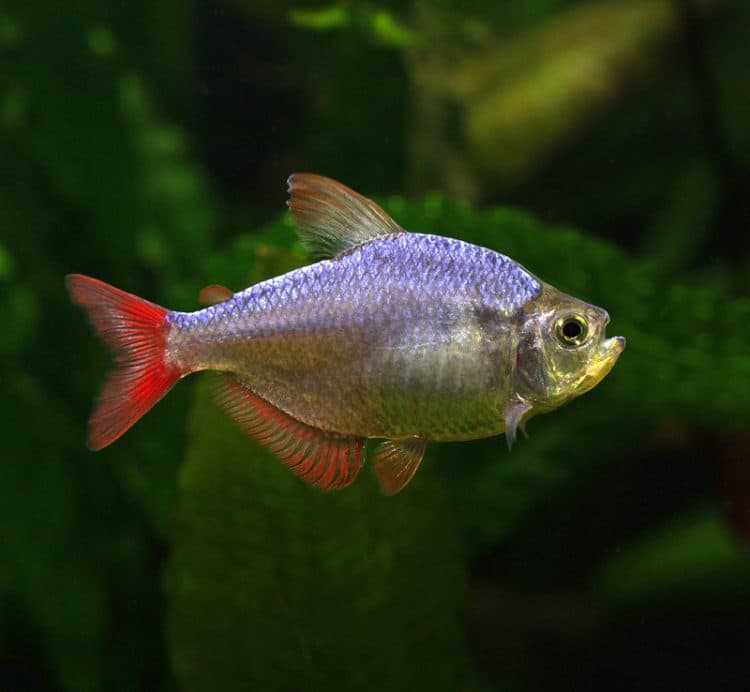
The Columbian Tetra or Blue-Red Columbian Tetra is a fish with a very chequered past, considering its relatively short life within the hobby. Only available for the past few years, the fish was first collected in a small stream upstream from Acandi, in the Rio Acandi drainage system near the Atlantic coast of Colombia. It was described as being “close to” Hyphessobrycon ecuadoriensis; some in the hobby conveniently ignored the “close to” and used this name anyway. It would seem strange that a fish found in Colombia and called the Columbian Tetra would have the specific name ecuadoriensis! Some time later it was suggested that it was not a Hyphessobrycon at all but rather a member of the genus Astyanax.
Things stayed this way until late 2001 when Zarske and Géry definitively described the fish as Hyphessobrycon columbianus – a much better name for a fish from Colombia, even though the country’s name is misspelled.
The fish grows to about two or two and a half inches with the males growing a little bigger than the females. Males exhibit more fin development than do the females but until fully grown they are not the easiest species to sex. Both sexes, as the common name implies, are shades of blue and red – the blue mostly in the body and the red in the fins. All in all they are distinctive and attractive fish.
In my experience they make quite acceptable community fish. I’ve kept them with considerably smaller fish and the Columbian Tetras haven’t bothered them.
For the past few years these tetras have been a common sight in pet shops and a tankful of them makes a nice display. For some reason, the price of the Columbian has remained high (for this type of tetra). The fish are likely being bred commercially since the collection sites are said to be extremely remote and not easily accessible.
Aquarium breeding, according to the literature is easily accomplished. One text says they are “egg scatterers, even on bare glass”. This may be true but I have found that H. columbianus is neither the easiest nor the hardest tetra to spawn. A breeding setup for these fish is typical for the group. Although a five gallon tank may do, a ten is probably better. I used a bare ten gallon tank with a spawning grid on the bottom as well as a couple of sinking mops. The water consisted of about one third RO water and two thirds tap water which resulted in water of about 200 micros. The female was put in the tank first in order to allow her to adjust and feel comfortable. Another reason I did this was that the first time I tried to breed these fish (about a year ago) I put the pair in the tank at the same time and the male drove the female so relentlessly that she died.
I added the male a day later and waited for eggs. The tank was checked each day for the next four or five days and although the two fish seemed interested in each other, there were no eggs. At that point I lost interest and started paying less attention to them. Four or five days later I wanted the tank for something else and, as I removed the adults, I could see a few silver slivers (fry) scooting about the bottom. As well, there were eggs on the bottom. The fish had spawned at least twice in the previous five days.
After the next three days or so, all of the eggs had hatched and some fry were free swimming. The free swimming fry appeared, in my opinion, large enough to not need infusoria. As a result I fed microworms and vinegar eels as first foods. In retrospect I think that infusoria or liquafry would have been preferable since about half of the 100 or so fry ended up dead. It was nearly three weeks before they were able to eat newly hatched brine shrimp and this slow initial growth is also an indication that infusoria would have been a good idea.
Once the fry began to eat baby shrimp they grew rapidly and probably doubled in size in the next week.
About fifty fry remain from the spawning and seem to now be doing well. I’m sure that with appropriate first foods, many more could result from a spawning.
Leave a Reply